新阅读 答案
- 格式:doc
- 大小:46.50 KB
- 文档页数:5

Unit1Reading for information1D 2C 3B 4A 5B 6CTranslation1 今天你们将离开培育你们的学术环境,直面真实的世界。
2 你们即将离开学校,终于可以开始接受教育了。
3 想找到一位保守的教授,那比要找到一个雪人还难。
若想挑战一些有关政治正确性的正统观点,那你将污名缠身。
4 如果你不相信我的话,那不妨去问一问那些因信奉网络公司是通往财富之路这一理论而破产的人们。
现实击碎了他们的梦想。
5 因此,欢迎你来到我们生活的这个理性的世界。
一旦你把那些白日梦拒之门外,你就会发现这个世界并不是太糟。
Summary1 emerge from/face the real world/go about2 commitment to/benefit from3 the enjoyment of reading/ was associated with4 reallity/theory/realist/in theory5 wishful thinking/ go for/wind up with/twists and turnsUnit 2Reading for information1B 2A 3D 4C 5B 6DTranslation1 爱是一种艺术吗?如果是,它就需要靠知识和努力来争取。
或者爱是一种愉快的感受,能否体验到它是机率问题,如果一个人运气好就能够“坠入爱河”?2 大多数人认为爱这个问题主要是被爱,而不是主动去爱,或者主动去爱的能力。
因此,他们的问题便是如何被爱,怎么样变得招人爱。
3 关于爱没有什么可学,这一想法背后的第二个前提是一个假设,此假设认为爱的问题是对象的问题,而不是能力的问题。
4 我来做一笔交易:爱的对象从它的社会价值来看应该是最理想的,与此同时他也应该处于对我的显性的和隐性的资质和潜力的考虑而接纳我。
5 两个人变得很熟悉了,他们的亲密感越来越多地失去了神秘色彩,直到他们的对抗、失望和彼此的厌倦抹杀了最初兴奋感消逝后残留下来的点滴东西。
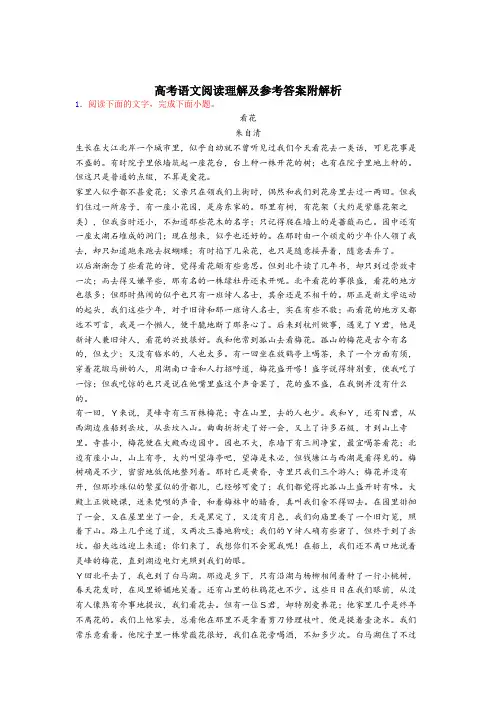
高考语文阅读理解及参考答案附解析1.阅读下面的文字,完成下面小题。
看花朱自清生长在大江北岸一个城市里,似乎自幼就不曾听见过我们今天看花去一类话,可见花事是不盛的。
有时院子里依墙筑起一座花台,台上种一株开花的树;也有在院子里地上种的。
但这只是普通的点缀,不算是爱花。
家里人似乎都不甚爱花;父亲只在领我们上街时,偶然和我们到花房里去过一两回。
但我们住过一所房子,有一座小花园,是房东家的。
那里有树,有花架(大约是紫藤花架之类),但我当时还小,不知道那些花木的名字;只记得爬在墙上的是蔷薇而已。
园中还有一座太湖石堆成的洞门;现在想来,似乎也还好的。
在那时由一个顽皮的少年仆人领了我去,却只知道跑来跑去捉蝴蝶;有时掐下几朵花,也只是随意挼弄着,随意丢弃了。
以后渐渐念了些看花的诗,觉得看花颇有些意思。
但到北平读了几年书,却只到过崇效寺一次;而去得又嫌早些,那有名的一株绿牡丹还未开呢。
北平看花的事很盛,看花的地方也很多;但那时热闹的似乎也只有一班诗人名士,其余还是不相干的。
那正是新文学运动的起头,我们这些少年,对于旧诗和那一班诗人名士,实在有些不敬;而看花的地方又都远不可言,我是一个懒人,便干脆地断了那条心了。
后来到杭州做事,遇见了Y君,他是新诗人兼旧诗人,看花的兴致很好。
我和他常到孤山去看梅花。
孤山的梅花是古今有名的,但太少;又没有临水的,人也太多。
有一回坐在放鹤亭上喝茶,来了一个方面有须,穿着花缎马褂的人,用湖南口音和人打招呼道,梅花盛开嗒!盛字说得特别重,使我吃了一惊;但我吃惊的也只是说在他嘴里盛这个声音罢了,花的盛不盛,在我倒并没有什么的。
有一回,Y来说,灵峰寺有三百株梅花;寺在山里,去的人也少。
我和Y,还有N君,从西湖边雇船到岳坟,从岳坟入山。
曲曲折折走了好一会,又上了许多石级,才到山上寺里。
寺甚小,梅花便在大殿西边园中。
园也不大,东墙下有三间净室,最宜喝茶看花;北边有座小山,山上有亭,大约叫望海亭吧,望海是未必,但钱塘江与西湖是看得见的。
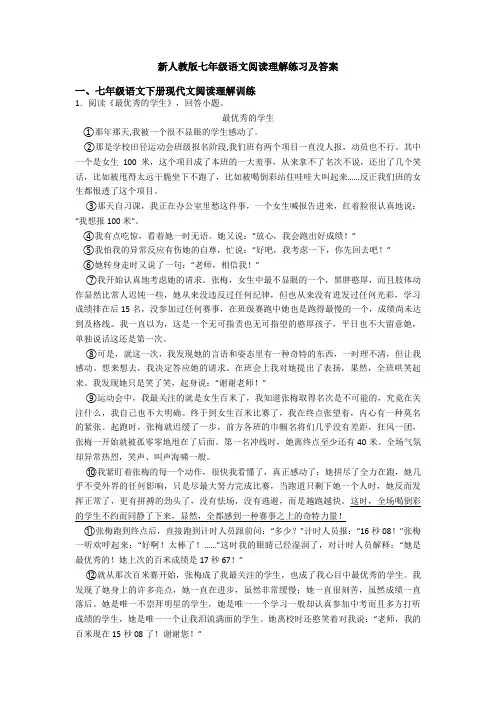
新人教版七年级语文阅读理解练习及答案一、七年级语文下册现代文阅读理解训练1.阅读《最优秀的学生》,回答小题。
最优秀的学生①那年那天,我被一个很不显眼的学生感动了。
②那是学校田径运动会班级报名阶段,我们班有两个项目一直没人报,动员也不行。
其中一个是女生100 米,这个项目成了本班的一大羞事,从来拿不了名次不说,还出了几个笑话,比如被甩得太远干脆坐下不跑了,比如被喝倒彩站住哇哇大叫起来……反正我们班的女生都恨透了这个项目。
③那天自习课,我正在办公室里愁这件事,一个女生喊报告进来,红着脸很认真地说:“我想报100米”。
④我有点吃惊,看着她一时无语。
她又说:“放心,我会跑出好成绩!”⑤我怕我的异常反应有伤她的自尊,忙说:“好吧,我考虑一下,你先回去吧!”⑥她转身走时又说了一句:“老师,相信我!”⑦我开始认真地考虑她的请求。
张梅,女生中最不显眼的一个,黑胖憨厚,而且肢体动作显然比常人迟钝一些,她从来没违反过任何纪律,但也从来没有迸发过任何光彩,学习成绩排在后15名,没参加过任何赛事,在班级赛跑中她也是跑得最慢的一个,成绩尚未达到及格线。
我一直以为,这是一个无可指责也无可指望的憨厚孩子,平日也不大留意她,单独说话这还是第一次。
⑧可是,就这一次,我发现她的言语和姿态里有一种奇特的东西,一时理不清,但让我感动。
想来想去,我决定答应她的请求。
在班会上我对她提出了表扬,果然,全班哄笑起来。
我发现她只是笑了笑,起身说:“谢谢老师!”⑨运动会中,我最关注的就是女生百米了,我知道张梅取得名次是不可能的,究竟在关注什么,我自己也不大明确。
终于到女生百米比赛了,我在终点张望着,内心有一种莫名的紧张。
起跑时,张梅就迟缓了一步,前方各班的巾帼名将们几乎没有差距,狂风一团,张梅一开始就被孤零零地甩在了后面。
第一名冲线时,她离终点至少还有40米。
全场气氛却异常热烈,笑声、叫声海啸一般。
⑩我紧盯着张梅的每一个动作,很快我看懂了,真正感动了:她拼尽了全力在跑,她几乎不受外界的任何影响,只是尽最大努力完成比赛,当跑道只剩下她一个人时,她反而发挥正常了,更有拼搏的劲头了,没有怯场,没有逃避,而是越跑越快。
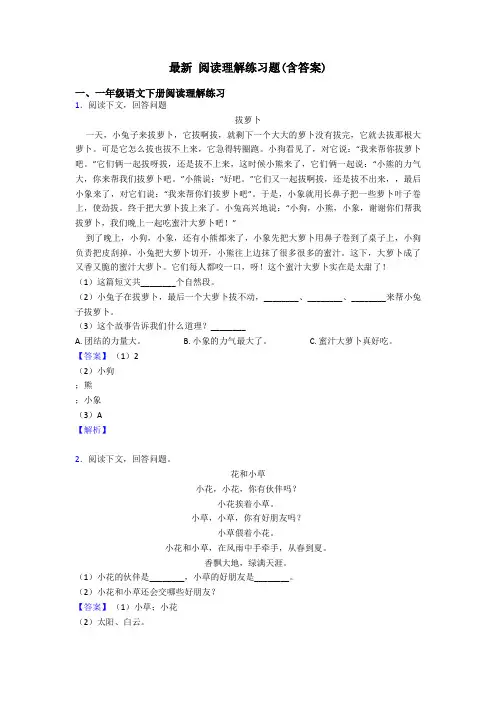
最新阅读理解练习题(含答案)一、一年级语文下册阅读理解练习1.阅读下文,回答问题拔萝卜一天,小兔子来拔萝卜,它拔啊拔,就剩下一个大大的萝卜没有拔完,它就去拔那根大萝卜。
可是它怎么拔也拔不上来,它急得转圈跑。
小狗看见了,对它说:“我来帮你拔萝卜吧。
”它们俩一起拔呀拔,还是拔不上来,这时候小熊来了,它们俩一起说:“小熊的力气大,你来帮我们拔萝卜吧。
”小熊说:“好吧。
”它们又一起拔啊拔,还是拔不出来,,最后小象来了,对它们说:“我来帮你们拔萝卜吧”。
于是,小象就用长鼻子把一些萝卜叶子卷上,使劲拔。
终于把大萝卜拔上来了。
小兔高兴地说:“小狗,小熊,小象,谢谢你们帮我拔萝卜,我们晚上一起吃蜜汁大萝卜吧!”到了晚上,小狗,小象,还有小熊都来了,小象先把大萝卜用鼻子卷到了桌子上,小狗负责把皮刮掉,小兔把大萝卜切开,小熊往上边抹了很多很多的蜜汁。
这下,大萝卜成了又香又脆的蜜汁大萝卜。
它们每人都咬一口,呀!这个蜜汁大萝卜实在是太甜了!(1)这篇短文共________个自然段。
(2)小兔子在拔萝卜,最后一个大萝卜拔不动,________、________、________来帮小兔子拔萝卜。
(3)这个故事告诉我们什么道理?________A. 团结的力量大。
B. 小象的力气最大了。
C. 蜜汁大萝卜真好吃。
【答案】(1)2(2)小狗;熊;小象(3)A【解析】2.阅读下文,回答问题。
花和小草小花,小花,你有伙伴吗?小花挨着小草。
小草,小草,你有好朋友吗?小草偎着小花。
小花和小草,在风雨中手牵手,从春到夏。
香飘大地,绿满天涯。
(1)小花的伙伴是________,小草的好朋友是________。
(2)小花和小草还会交哪些好朋友?【答案】(1)小草;小花(2)太阳、白云。
【解析】3.读短文,回答后面的问题。
快乐的夏天去年夏天,我过得特别快乐。
爷爷带我来到小兰家。
小兰比我大一岁,她的家在山区,家里比较穷,爷爷决定资助她上学。
每天,我和小兰一起去上坡放羊、割草、捉蝈蝈,特别开心。
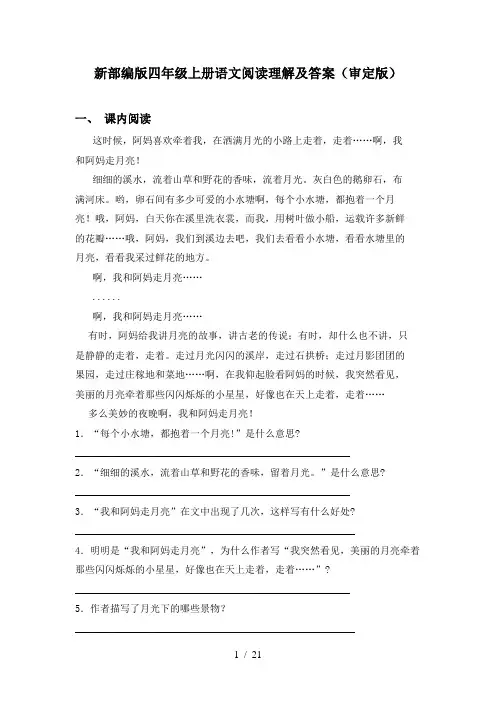
新部编版四年级上册语文阅读理解及答案(审定版)一、课内阅读这时候,阿妈喜欢牵着我,在洒满月光的小路上走着,走着……啊,我和阿妈走月亮!细细的溪水,流着山草和野花的香味,流着月光。
灰白色的鹅卵石,布满河床。
哟,卵石间有多少可爱的小水塘啊,每个小水塘,都抱着一个月亮!哦,阿妈,白天你在溪里洗衣裳,而我,用树叶做小船,运载许多新鲜的花瓣……哦,阿妈,我们到溪边去吧,我们去看看小水塘,看看水塘里的月亮,看看我采过鲜花的地方。
啊,我和阿妈走月亮……......啊,我和阿妈走月亮……有时,阿妈给我讲月亮的故事,讲古老的传说;有时,却什么也不讲,只是静静的走着,走着。
走过月光闪闪的溪岸,走过石拱桥;走过月影团团的果园,走过庄稼地和菜地……啊,在我仰起脸看阿妈的时候,我突然看见,美丽的月亮牵着那些闪闪烁烁的小星星,好像也在天上走着,走着……多么美妙的夜晚啊,我和阿妈走月亮!1.“每个小水塘,都抱着一个月亮!”是什么意思?_______________________________________________________2.“细细的溪水,流着山草和野花的香味,留着月光。
”是什么意思?_______________________________________________________3.“我和阿妈走月亮”在文中出现了几次,这样写有什么好处?________________________________________________________4.明明是“我和阿妈走月亮”,为什么作者写“我突然看见,美丽的月亮牵着那些闪闪烁烁的小星星,好像也在天上走着,走着……”?_______________________________________________________5.作者描写了月光下的哪些景物?________________________________________________________二、阅读短文,完成练习。
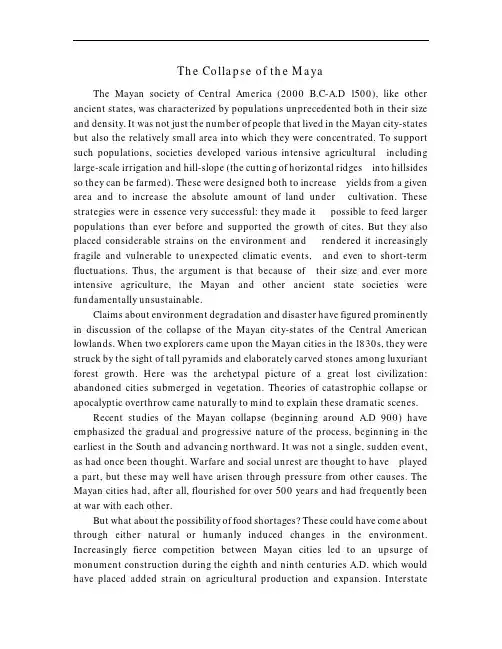
The Collapse of the MayaThe Mayan society of Central America (2000 B.C-A.D 1500), like other ancient states, was characterized by populations unprecedented both in their size and density. It was not just the number of people that lived in the Mayan city-states but also the relatively small area into which they were concentrated. To support such populations, societies developed various intensive agricultural including large-scale irrigation and hill-slope (the cutting of horizontal ridges into hillsides so they can be farmed). These were designed both to increase yields from a given area and to increase the absolute amount of land under cultivation. These strategies were in essence very successful: they made it possible to feed larger populations than ever before and supported the growth of cites. But they also placed considerable strains on the environment and rendered it increasingly fragile and vulnerable to unexpected climatic events, and even to short-term fluctuations. Thus, the argument is that because of their size and ever more intensive agriculture, the Mayan and other ancient state societies were fundamentally unsustainable.Claims about environment degradation and disaster have figured prominently in discussion of the collapse of the Mayan city-states of the Central American lowlands. When two explorers came upon the Mayan cities in the 1830s, they were struck by the sight of tall pyramids and elaborately carved stones among luxuriant forest growth. Here was the archetypal picture of a great lost civilization: abandoned cities submerged in vegetation. Theories of catastrophic collapse or apocalyptic overthrow came naturally to mind to explain these dramatic scenes.Recent studies of the Mayan collapse (beginning around A.D 900) have emphasized the gradual and progressive nature of the process, beginning in the earliest in the South and advancing northward. It was not a single, sudden event, as had once been thought. Warfare and social unrest are thought to have played a part, but these may well have arisen through pressure from other causes. The Mayan cities had, after all, flourished for over 500 years and had frequently been at war with each other.But what about the possibility of food shortages? These could have come about through either natural or humanly induced changes in the environment. Increasingly fierce competition between Mayan cities led to an upsurge of monument construction during the eighth and ninth centuries A.D, which would have placed added strain on agricultural production and expansion. Interstaterivalry may hence have pushed the Maya toward overexploitation of their fragile ecosystem. Deforestation and soil erosion might ultimately have destroyed the capacity of the land to support the high population levels of the Mayan cities, leading to famine, social unrest, and the collapse of the major Mayan centers.Yet it may be incorrect to lay the blame entirely on human action. Several of the lowland cities, such as Tikal, appear to have depended heavily on the cultivation of raised fields set in the marshy depressions known as bajos, which today flood intermittently in the rainy season but may originally have been permanent lakes. The raise-field system of intensive cultivation (created by digging surrounding canals and using the soil removed to elevate the fields for planting) allows year-round food production through the constant supply of soil nutrients that erode into the drainage ditches dug around the raised fields, nutrients that are then collected and replaced. Stable water levels were essential to this subsistence system, but evidence from Lake Chichancanab in Yucatan shows that between A.D 800 and A.D 1000 this region suffered its driest period of climate in several thousand years. We may expect that as a result water level fell, and the raised fields in many areas became unusable. But the human response must be viewed through the lens of the social, political, and cultural circumstances. These exerted a powerful mediating effect on the way the Maya endeavored to cope with their difficulties. Had population levels been lower, the impact of the drought may not have been catastrophic, as it was, the Maya were already reaching the limits of the available subsistence capacity, and Mayan elites had espoused certain social and political agendas (including expensive warfare and competition with each other). It was against this specific background that a period of drought led quickly to crisis and collapse.Paragraph 1The Mayan society of Central America (2000 B.C-A.D 1500), like other ancient states, was characterized by populations unprecedented both in their size and density. It was not just the number of people that lived in the Mayan city-states but also the relatively small area into which they were concentrated. To support such populations, societies developed various intensive agricultural including large-scale irrigation and hill-slope (the cutting of horizontal ridges into hillsides so they can be farmed). These were designed both to increase yields from a given area and to increase the absolute amount of land under cultivation. Thesestrategies were in essence very successful: they made it possible to feed larger populations than ever before and supported the growth of cites. But they also placed considerable strains on the environment and rendered it increasingly fragile and vulnerable to unexpected climatic events, and even to short-term fluctuations. Thus, the argument is that because of their size and ever more intensive agriculture, the Mayan and other ancient state societies were fundamentally unsustainable.1.According to paragraph 1, ancient societies increased their agricultural output byA. increasing the percentage of the population that worked as farmersB. creating large irrigation systemsC. being highly selective of the fields they would farmD. moving more people into the city to free up farmland2.Which of the following can be inferred from paragraph 1 about the intensive agricultural methods of the Maya?A. They helped the Maya overcome shot-term fluctuations in the climate.B. They could not supply all of the food required for the growth of Mayan cities.C. They strained the environment more than the Maya’s previous farmingtechniques did.D. They were invented by the Maya to help them grow new kinds of crops. Paragraph2Claims about environment degradation and disaster have figured prominently in discussion of the collapse of the Mayan city-states of the Central American lowlands. When two explorers came upon the Mayan cities in the 1830s, they were struck by the sight of tall pyramids and elaborately carved stones among luxuriant forest growth. Here was the archetypal picture of a great lost civilization: abandoned cities submerged in vegetation. Theories of catastrophic collapse or apocalyptic overthrow came naturally to mind to explain these dramatic scenes.3.The word “elaborately” in the passage is closest in meaning toA. with great detailB. artisticallyC. mysteriouslyD. gently hand-made4.The word “abandoned” in the passage is closest in meaning toA. carefully hiddenB. destroyedC. enormousD. no longer occupied5.In paragraph 2, the author implies which of the following about the collapse of the Mayan city-states?A. The fact that vegetation had grow over the ruins of Mayan buildings indicatesthat environmental degradation did not contribute to the Mayan collapse.B. Early explorers supposed that there was a catastrophic collapse of the Mayancity states largely because this view fit their preconceived ideas about lost civilizations.C. The condition of the tall pyramids and carved stones discovered by earlyexplorers proves that Mayan city-states were violently overthrown.D. The Mayan cities were abandoned because they became submerged invegetationParagraph 3Recent studies of the Mayan collapse (beginning around A.D 900) have emphasized the gradual and progressive nature of the process, beginning in the earliest in the South and advancing northward. It was not a single, sudden event, as had once been thought. Warfare and social unrest are thought to have played a part, but these may well have arisen through pressure from other causes. The Mayan cities had, after all, flourished for over 500years and had frequently been at war with each other.6.Why does the author include the information that Mayan cities had “flourished for over 500 years and had frequently been at war with each other”?A. To identify a possible reason for the eventual collapse of Mayan societyB. To make the point that war and social unrest alone do not account for theMayan collapseC. To explain why recent studies argue that human actions were responsible forthe Mayan collapseD. To provide evidence that frequent wars weakened Mayan society only verygradually7.According to paragraph 3, recent studies claim which of the following about the Mayan collapse?A. It was caused primarily by frequent wars between rival city-states.B. It was caused by a single sudden event.C. It was preceded by social unrest in northern city-states.D. It began in southern city-states and spread to others.Paragraph 4But what about the possibility of food shortage? These could have come about through either natural or humanly induced changes in the environment. Increasingly fierce competition between Mayan cities led to an upsurge of monument construction during the eighth and ninth centuries A.D, which would have placed added strain on agricultural production and expansion. Interstate rivalry may hence have pushed the Maya toward overexploitation oftheir fragile ecosystem. Deforestation and soil erosion might ultimately have destroyed the capacity of the land to support the high population levels of the Mayan cities, leading to famine, social unrest, and the collapse of the major Mayan centers.8.All of the following are mentioned in paragraph 4 as possible direct or indirect caused of food shortages EXCEPTA. increased monument constructionB. rivalries between statesC. deforestation and stationD. introduction of new cropsParagraph 5Yet it may be incorrect to lay the blame entirely on human action. Several of the lowland cities, such as Tikal, appear to have depended heavily on the cultivation of raised fields set in the marshy depressions known as bajos, which today flood intermittently in the rainy season but may originally have been permanent lakes. The raise-field system of intensive cultivation (created by digging surrounding canals and using the soil removed to elevate the fields for planting) allows year-round food production through the constant supply of soil nutrients that erode into the drainage ditches dug around the raised fields, nutrients that are then collected and replaced. Stable water levels were essential to this subsistence system, but evidence from Lake Chichancanab in Yucatan shows that betweenA.D 800 and A.D 1000 this region suffered its driest period of climate in several thousand years. We may expect that as a result water level fell, and the raised fields in many areas became unusable. But the human response must be viewed through the lens of the social, political, and cultural circumstances. These exerted a powerful mediating effect on the way the Maya endeavored to cope with their difficulties. Had population levels been lower, the impact of the drought may not have been catastrophic, as it was, the Maya were already reaching the limits of the available subsistence capacity, and Mayan elites had espoused certain social and political agendas (including expensive warfare and competition with each other). It was against this specific background that a period of drought led quickly to crisis and collapse.9.The word “entirely” in the passage is closest in meaning toA. generallyB. clearlyC. completelyD. specifically10.The word “intermittently” in the passage is closest in meaning toA. constantlyB. periodicallyC. usuallyD. especially11.According to paragraph 5, why did the raised fields in many areas become unusable?A. The marshy depressions around the fields flooded in the rainy seasonB. Intensive cultivation of the fields drained the soil of nutrients.C. The area where the fields were located experienced a drop in water levels.D. Unstable design caused the failure of the drainage ditches.12.According to paragraph 5, all of the following made it more difficult for the Maya to cope with effects of the drought EXCEPTA. failure to properly cultivate the fieldsB. high population levelsC. competition between Mayan groupsD. warfareParagraph 5Yet it may be incorrect to lay the blame entirely on human action. 【A】Several of the lowland cities, such as Tikal, appear to have depended heavily on the cultivation of raised fields set in the marshy depressions known as bajos, which today flood intermittently in the rainy season but may originally have been permanent lakes. 【B】The raise-field system of intensive cultivation (created by digging surrounding canals and using the soil removed to elevate the fields for planting) allows year-round food production through the constant supply of soil nutrients that erode into the drainage ditches dug around the raised fields, nutrients that are then collected and replaced. 【C】Stable water levels were essential to this subsistence system, but evidence from Lake Chichancanab in Yucatan shows that between A.D 800 and A.D 1000 this region suffered its driest period of climate in several thousand years. 【D】We may expect that as a result water level fell, and the raised fields in many areas became unusable. But the human response must be viewed through the lens of the social, political, and cultural circumstances. These exerted a powerful mediating effect on the way the Maya endeavored to cope with their difficulties. Had population levels been lower, the impact of the drought may not have been catastrophic, as it was, the Maya were already reaching the limits of the available subsistence capacity, and Mayan elites had espoused certain social and political agendas (including expensive warfare and competition with each other). It was against this specific background that a period of drought led quickly to crisis and collapse.13.Look at the four squares [■] that indicate where the following sentence could be added to the passage.Nature apparently also contributed to the food shortages.Where would the sentence best fit?14.Directions:An introductory sentence for a brief summary of the passage is provided below. Complete the summary by selecting the THREE answer choices that express the most important ideas in the passage. Some sentences do not belong in the summary because they express ideas that are not presented in the passage or are minor ideas in the passage. This question is worth 2 points.Since the discovery of the Mayan ruins in the 1830s, researchers have tried to explain the collapse of Mayan civilization.Answer choicesA. The Mayan attempt to develop intensive agricultural methods to support largepopulations in relatively small areas probably was unsuccessful and couldhave caused the Mayan collapse.B. The discovery of intact pyramids submerged in vegetation among the Mayanruins led researchers to believe that Mayan cities were simply overgrownrather than catastrophically destroyed.C. Warfare and rivalry between Mayan states may have caused food shortagesthat contributed to the eventual collapse of Mayan civilization.D. Early theories that the Mayan collapse was a sudden, catastrophic event werefollowed by views that treated the collapse as a gradual process.E. The continuing warfare and social unrest that started in the North and spreadto the South provided researchers with evidence that the Mayan collapse tookhundreds of years to occur.F. Drought between A. D. 800 and A.D. 1000 likely caused the Mayan system ofintensive irrigated agriculture to fall, which could have brought about a rapidcollapse of the Mayan states.参考答案:BCADB BDDCB CAA CDF。
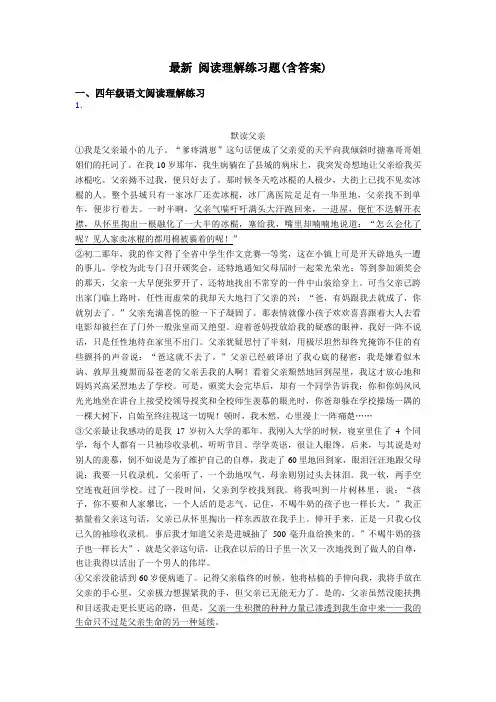
最新阅读理解练习题(含答案)一、四年级语文阅读理解练习1.默读父亲①我是父亲最小的儿子。
“爹疼满崽”这句话便成了父亲爱的天平向我倾斜时搪塞哥哥姐姐们的托词了。
在我10岁那年,我生病躺在了县城的病床上,我突发奇想地让父亲给我买冰棍吃。
父亲拗不过我,便只好去了。
那时候冬天吃冰棍的人极少,大街上已找不见卖冰棍的人。
整个县城只有一家冰厂还卖冰棍,冰厂离医院足足有一华里地,父亲找不到单车,便步行着去。
一时半晌,父亲气喘吁吁满头大汗跑回来,一进屋,便忙不迭解开衣襟,从怀里掏出一根融化了一大半的冰棍,塞给我,嘴里却喃喃地说道:“怎么会化了呢?见人家卖冰棍的都用棉被裹着的呢!”②初二那年,我的作文得了全省中学生作文竞赛一等奖,这在小镇上可是开天辟地头一遭的事儿。
学校为此专门召开颁奖会,还特地通知父母届时一起荣光荣光;等到参加颁奖会的那天,父亲一大早便张罗开了,还特地找出不常穿的一件中山装给穿上。
可当父亲已跨出家门临上路时,任性而虚荣的我却天大地扫了父亲的兴:“爸,有妈跟我去就成了,你就别去了。
”父亲充满喜悦的脸一下子凝固了。
那表情就像小孩子欢欢喜喜跟着大人去看电影却被拦在了门外一般张皇而又绝望。
迎着爸妈投放给我的疑惑的眼神,我好一阵不说话,只是任性地待在家里不出门。
父亲犹疑思忖了半刻,用极尽坦然却终究掩饰不住的有些颤抖的声音说:“爸这就不去了。
”父亲已经破译出了我心底的秘密:我是嫌看似木讷、敦厚且瘦黑而显苍老的父亲丢我的人啊!看着父亲颓然地回到屋里,我这才放心地和妈妈兴高采烈地去了学校。
可是,颁奖大会完毕后,却有一个同学告诉我:你和你妈风风光光地坐在讲台上接受校领导授奖和全校师生羡慕的眼光时,你爸却躲在学校操场一隅的一棵大树下,自始至终注视这一切呢!顿时,我木然,心里漫上一阵痛楚……③父亲最让我感动的是我17岁初入大学的那年。
我刚入大学的时候,寝室里住了4个同学,每个人都有一只袖珍收录机,听听节目、学学英语,很让人眼馋。
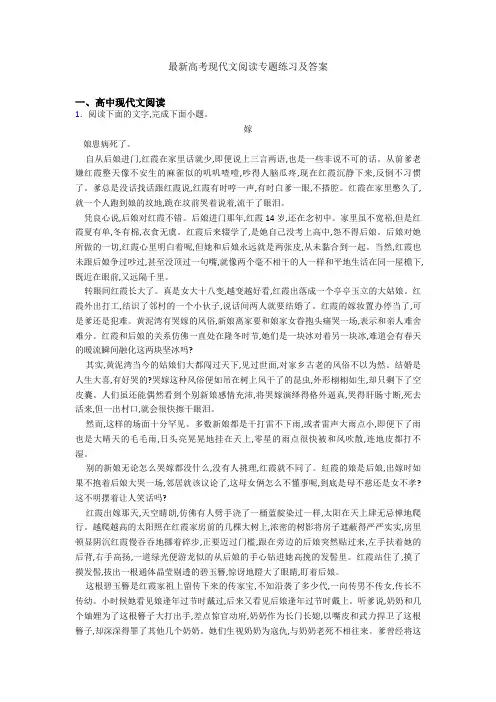
最新高考现代文阅读专题练习及答案一、高中现代文阅读1.阅读下面的文字,完成下面小题。
嫁娘患病死了。
自从后娘进门,红霞在家里话就少,即便说上三言两语,也是一些非说不可的话。
从前爹老嫌红霞整天像不安生的麻雀似的叽叽喳噎,吵得人脑瓜疼,现在红霞沉静下来,反倒不习惯了。
爹总是没话找话跟红霞说,红霞有时哼一声,有时白爹一眼,不搭腔。
红霞在家里憋久了,就一个人跑到娘的坟地,跪在坟前哭着说着,流干了眼泪。
凭良心说,后娘对红霞不错。
后娘进门那年,红霞14岁,还在念初中。
家里虽不宽裕,但是红霞夏有单,冬有棉,衣食无虞。
红霞后来辍学了,是她自己没考上高中,怨不得后娘。
后娘对她所做的一切,红霞心里明白着呢,但她和后娘永远就是两张皮,从未黏合到一起。
当然,红霞也未跟后娘争过吵过,甚至没顶过一句嘴,就像两个毫不相干的人一样和平地生活在同一屋檐下,既近在眼前,又远隔千里。
转眼间红霞长大了。
真是女大十八变,越变越好看,红霞出落成一个亭亭玉立的大姑娘。
红霞外出打工,结识了邻村的一个小伙子,说话间两人就要结婚了。
红霞的嫁妆置办停当了,可是爹还是犯难。
黄泥湾有哭嫁的风俗,新娘离家要和娘家女眷抱头痛哭一场,表示和亲人难舍难分。
红霞和后娘的关系仿佛一直处在隆冬时节,她们是一块冰对着另一块冰,难道会有春天的暖流瞬间融化这两块坚冰吗?其实,黄泥湾当今的姑娘们大都闯过天下,见过世面,对家乡古老的风俗不以为然。
结婚是人生大喜,有好哭的?哭嫁这种风俗便如吊在树上风干了的昆虫,外形栩栩如生,却只剩下了空皮囊。
人们虽还能偶然看到个别新娘感情充沛,将哭嫁演绎得格外逼真,哭得肝肠寸断,死去活来,但一出村口,就会很快擦干眼泪。
然而,这样的场面十分罕见。
多数新娘都是干打雷不下雨,或者雷声大雨点小,即便下了雨也是大晴天的毛毛雨,日头亮晃晃地挂在天上,零星的雨点很快被和风吹散,连地皮都打不湿。
别的新娘无论怎么哭嫁都没什么,没有人挑理,红霞就不同了。
紅霞的娘是后娘,出嫁时如果不抱着后娘大哭一场,邻居就该议论了,这母女俩怎么不懂事呢,到底是母不慈还是女不孝?这不明摆着让人笑话吗?红霞出嫁那天,天空睛朗,仿佛有人劈手浇了一桶蓝靛染过一样,太阳在天上肆无忌惮地爬行。
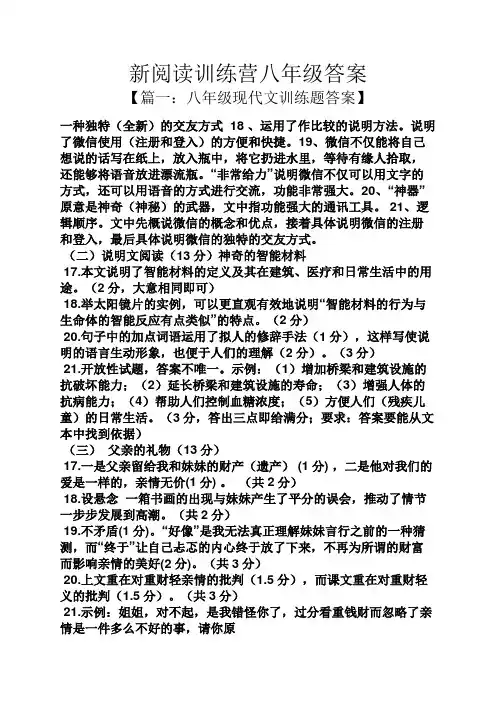
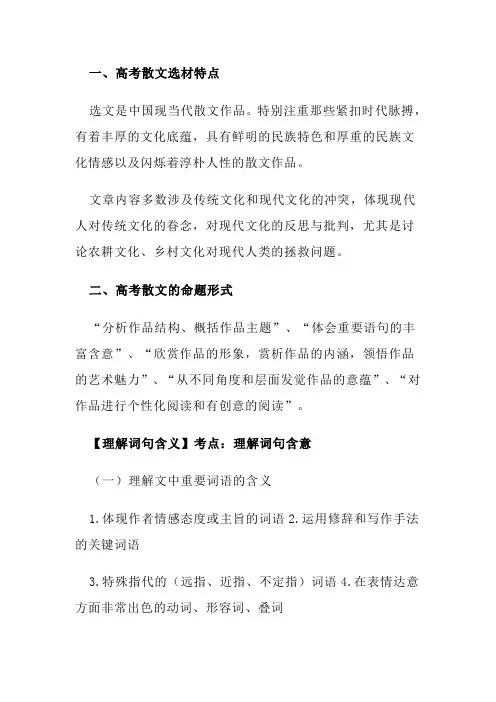
一、高考散文选材特点选文是中国现当代散文作品。
特别注重那些紧扣时代脉搏,有着丰厚的文化底蕴,具有鲜明的民族特色和厚重的民族文化情感以及闪烁着淳朴人性的散文作品。
文章内容多数涉及传统文化和现代文化的冲突,体现现代人对传统文化的眷念,对现代文化的反思与批判,尤其是讨论农耕文化、乡村文化对现代人类的拯救问题。
二、高考散文的命题形式“分析作品结构、概括作品主题”、“体会重要语句的丰富含意”、“欣赏作品的形象,赏析作品的内涵,领悟作品的艺术魅力”、“从不同角度和层面发觉作品的意蕴”、“对作品进行个性化阅读和有创意的阅读”。
【理解词句含义】考点:理解词句含意(一)理解文中重要词语的含义1.体现作者情感态度或主旨的词语2.运用修辞和写作手法的关键词语3.特殊指代的(远指、近指、不定指)词语4.在表情达意方面非常出色的动词、形容词、叠词5.有特殊用法的词语,包含贬义褒用、褒义贬用、大词小用、小词大用、词性活用等。
答题模板:1.分析用了什么修辞手法,如比喻、拟人等;若没有,则不写这一点。
2.表面意义(表面上的意思)和表达效果(生动形象地写出了……特点)3.深层含义(联系上下文、主题、作者意图,蕴含了什么道理、思想、感情等)肯定了/褒扬了/赞美了/歌颂了或批判了/讽刺了/否定了/反驳了……,或者给了我们……的印象、启示、道理等。
(二)理解句子含意理解句意往往是理解文中重要句子的含意,所谓重要句子是指在文中起重要作用的关键性句子。
1.含蓄句——由表及里①表层含意:句子表面的意义②句内意义:句子的语境意义(临时意义)③句外意义:比喻义、象征义、指代义、反语义理解句意时,一般需要在理解主旨的基础上,借助“表层义”,联系语境,获取关键信息。
2.结构句——抓住位置①总领句②总结句③过渡句④照应句3.修辞句——还原本意首先,确定修辞手法,把握特点。
如比喻的相似性,反语的讽刺性、借代的相关性,比拟的形象性。
其次,将句子还原,即将使用了修辞手法的句子还原成没有使用修辞手法意思明白的句子。
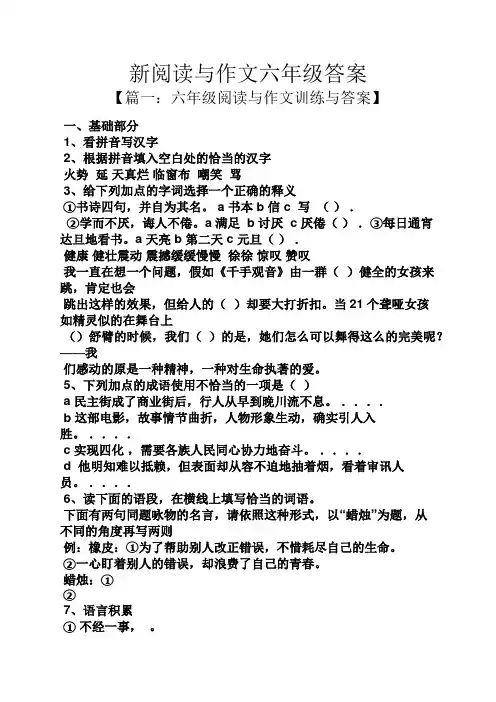
新阅读与作文六年级答案【篇一:六年级阅读与作文训练与答案】一、基础部分1、看拼音写汉字2、根据拼音填入空白处的恰当的汉字火势延天真烂临窗布嘲笑骂3、给下列加点的字词选择一个正确的释义①书诗四句,并自为其名。
a 书本 b 信 c 写().②学而不厌,诲人不倦。
a满足 b 讨厌 c 厌倦().③每日通宵达旦地看书。
a 天亮 b 第二天 c 元旦().健康健壮震动震撼缓缓慢慢徐徐惊叹赞叹我一直在想一个问题,假如《千手观音》由一群()健全的女孩来跳,肯定也会跳出这样的效果,但给人的()却要大打折扣。
当21个聋哑女孩如精灵似的在舞台上()舒臂的时候,我们()的是,她们怎么可以舞得这么的完美呢?——我们感动的原是一种精神,一种对生命执著的爱。
5、下列加点的成语使用不恰当的一项是()a 民主街成了商业街后,行人从早到晚川流不息。
....b 这部电影,故事情节曲折,人物形象生动,确实引人入胜。
....c 实现四化,需要各族人民同心协力地奋斗。
....d 他明知难以抵赖,但表面却从容不迫地抽着烟,看着审讯人员。
....6、读下面的语段,在横线上填写恰当的词语。
下面有两句同题咏物的名言,请依照这种形式,以“蜡烛”为题,从不同的角度再写两则例:橡皮:①为了帮助别人改正错误,不惜耗尽自己的生命。
②一心盯着别人的错误,却浪费了自己的青春。
蜡烛:①②7、语言积累①不经一事,。
②宝剑锋从磨砺出,。
③王维《送元二使安西》中有“劝君更尽一杯酒,西出阳关无故人”的诗句,高适《别董大》中有句与上述诗句中的“无故人”意思相反,这句诗是“。
”④每当我们遇到棘手的问题往往一筹莫展,可经过冥思苦想,会突然发现问题的根源,难题也就迎刃而解,真可谓,。
(陆游《游山西村》)8、语言运用①刘阿姨话的言外之意是。
②如果你是平平,你会怎样幽默而不失真诚地回答刘阿姨呢?二、文言文阅读(一)学者有四失学者有四失①,教者必知之。
人之学也,或失则多②,或失则寡,或失则易,或失则止③,心之莫同也④。
新语文阅读训练答案【篇一:五年级语文阅读练习题及答案免费】ass=txt>新春佳节之际,妈妈买来了一幅画。
我粗粗一看,这幅画并没有什么特别吸引人的地方。
我心想:书店里有那么多色彩鲜艳的年画,妈妈为什么要买这幅呢?我一边琢磨,一边细细欣赏起来。
这是一幅国画,画的背景是巍峨挺拔的高山,被淡淡的烟云笼罩着,使群山若隐若现,令人格外神往。
山坡下横插过来一株苍劲的松树,松树下是一对飞奔的骏马。
奔在前头的是一匹枣红马,它浑身火红,仰天长嘶,红色的鬃毛高高飘起,全身的肌肉结实得像拳击场上的运动员,一块一块地凸出来,显得十分健美有力。
枣红马腾空而起,柔软而漂亮的马尾巴甩得很起劲。
紧挨着枣红马旁边是一匹白马,从头到尾一片洁白。
连一根杂毛也没有,像一团白云轻轻飘来,显得那么洒脱矫健,分明是一匹千里马。
我越看越着迷,似乎听到了它们“得得”的马蹄声,看到了他们身后卷起的阵阵尘土,仿佛看见它们自由自在地飞驰在广阔的原野上。
这时,我猛然想起刚才的疑问,便跑去问妈妈。
妈妈神秘地笑了,反问我:“你属什么呀?”我恍然大悟,抢着说:“知道了,知道了,我属马,这年画上的马象征着我。
您希望我努力学习,不怕挫折,永远向前飞奔,对吗?”妈妈满意地点点头。
啊!马儿,你知道这是妈妈对我殷切的期望,我决心要让它变成现实。
1.填空。
(1)这幅国画画的是()、()、()、(),主要画的是()。
(2)妈妈买这幅画的目的是()。
2.用横线画出写“我”观画时联想的句子。
3.用‖把文章分成3段,用简洁的语句写出文章的叙述顺序。
_________________________________________4.写出文章的中心思想。
_________________________________________5.给短文加标题。
(二)深山含笑我以前见过的含笑花都是庭院种植的,叶细花小,象牙色的花蕊吐着幽香,有一种水果般的甜沁。
含笑不(以、已)艳丽著称,妙的是一缕沁香。
Into the UnknownThe world has never seen population ageing before. Can it cope?A.Until the early 1990s nobody much thought about whole populations getting old er. The UN had the foresight to convene a "world assembly on ageing" back in 198 2, but that came and went. By 1994 the World Bank had noticed that something bi g was happening. In a report entitled "Averting the Old Age Crisis", it argued that pension arrangements in most countries were unsustainable.B.For the next ten years a succession of books, mainly by Americans, sounded th e alarm. They had titles like Young vs Old, Gray Dawn and The Coming Generation al Storm, and their message was blunt: health-care systems were heading for the r ocks, pensioners were taking young people to the cleaners, and soon there would b e intergenerational warfare.C.Since then the debate has become less emotional, not least because a lot more is known about the subject.Books, conferences and research papers have multiplied. International organisations such as the OECD and the EU issue regular reports. Po pulation ageing is on every agenda, from G8 economic conferences to NATO summi ts. The World Economic Forum plans to consider the future of pensions and health care at its prestigious Davos conference early next year. The media, including this n ewspaper, are giving the subject extensive coverage.D.Whether all that attention has translated into sufficient action is another questio n. Governments in rich countries now accept that their pension and health-care pro mises will soon become unaffordable, and many of them have embarked on reforms, but so far only timidly. That is not surprising: politicians with an eye on the next election will hardly rush to introduce unpopular measures that may not bear fruit fo r years, perhaps decades.E.The outline of the changes needed is clear. To avoid fiscal (财政的) meltdown, public pensions and health- care provision will have to be reined back severely and taxes may have to go up. By far the most effective method to restrain pension spe nding is to give people the opportunity to work longer, because it increases tax rev enues and reduces spending on pensions at the same time. It may even keep them alive longer. John Rother, the AARP's head of policy and strategy, points to studies showing that other things being equal, people who remain at work have lower dea th rates than their retired peers.F.Younger people today mostly accept that they will have to work for longer and that their pensions will be less generous. Employers still need to be persuaded that older workers are worth holding on to. That may be because they have had plenty of younger ones to choose from, partly thanks to the post-war baby-boom and par tly because over the past few decades many more women have entered the labour force, increasing employers' choice. But the reservoir of women able and willing to take up paid work is running low, and the baby-boomers are going grey.G.In many countries immigrants have been filling such gaps in the labour force as have already emerged (and remember that the real shortage is still around ten ye ars off). Immigration in the developed world is the highest it has ever been, and itis making a useful difference. In still-fertile America it currently accounts for about 40% of total population growth, and in fast-ageing western Europe for about 90%. H.On the face of it, it seems the perfect solution. Many developing countries have lots of young people in need of jobs; many rich countries need helping hands that will boost tax revenues and keep up economic growth. But over the next few deca des labour forces in rich countries are set to shrink so much that inflows of immigr ants would have to increase enormously to compensate: to at least twice their curr ent size in western Europe's most outhful countries, and three times in the older on es. Japan would need a large multiple of the few immigrants it has at present. Pub lic opinion polls show that people in most rich countries already think that immigrati on is too high. Further big increases would be politically unfeasible.I.To tackle the problem of ageing populations at its root, "old" countries would h ave to rejuvenate (使年轻)themselves by having more of their own children. A num ber of them have tried, some more successfully than others. But it is not a simple matter of offering financial incentives or providing more child care. Modem urban lif e in rich countries is not well adapted to large families. Women find it hard to com bine family and career. They often compromise by having just one child.J.And if fertility in ageing countries does not pick up? It will not be the end of t he world, at least not for quite a while yet, but the world will slowly become a diff erent place. Older societies may be less innovative and more strongly disinclined to take risks than younger ones. By 2025 at the latest, about half the voters in Ameri ca and most of those in western European countries will be over 50-and older peop le turn out to vote in much greater number than younger ones. Academic studies h ave found no evidence so far that older voters have used their power at the ballot box to push for policies that specifically benefit them, though if in future there are many more of them they might start doing so.K.Nor is there any sign of the intergenerational warfare predicted in the 1990s. Af ter all, older people themselves mostly have families. In a recent study of parents a nd grown-up children in 11 European countries, Karsten Hank of Marmheim Universi ty found that 85% of them lived within 25km of each other and the majority of th em were in touch at least once a week.L.Even so, the shift in the centre of gravity to older age groups is bound to have a profound effect on societies, not just economically and politically but in all sorts of other ways too. Richard Jackson and Neil Howe of America's CSIS, in a thoughtf ul book called The Graying of the Great Powers, argue that, among other things, th e ageing of the developed countries will have a number of serious security implicati ons. M) For example, the shortage of young adults is likely to make countries more reluctant to commit the few they have to military service. In the decades to 2050, America will find itself playing an ever-increasing role in the developed world's defe nce effort. Because America's population will still be growing when that of most oth er developed countries is shrinking, America will be the only developed country that still matters geopolitically(地缘政治上).Ask me in 2020N) There is little that can be done to stop population ageing, so the world will hav e to live with it. But some of the consequences can be alleviated. Many experts no w believe that given the right policies, the effects, though grave,need not be catast rophic. Most countries have recognised the need to do something and are beginning to act.O) But even then there is no guarantee that their efforts will work. What is happen ing now is historically unprecedented. Ronald Lee, director of the Centre on the Eco nomics and Demography of Ageing at the University of California, Berkeley, puts it briefly and clearly: "We don't really know what population ageing will be like, becau se nobody has done it yet. "1、Employers should realise it is important to keep older workers in the workforce.不确定答案F3A recent study found that most old people in some European countries had regular weekly contact with their adult children.不确定答案K2、Few governments in rich countries have launched bold reforms to tackle the problem of population ageing.不确定答案D3、In a report published some 20 years ago, the sustainability of old age pension systems in most countries was called into doubt,不确定答案A4、Countries that have a shortage of young adults will be less willing to send them to war.不确定答案M5、7One-child families are more common in ageing societies due to the stress of urban life and the difficulties of balancing family and career.不确定答案I6、8A series of books, mostly authored by Americans, warned of conflicts between the older and younger generations.不确定答案B7、Compared with younger ones, older societies tend to be less innovative and take fewer risks.不确定答案J8、The best solution to the pension crisis is to postpone the retirement age.不确定答案E9、Immigration as a means to boost the shrinking labour force may meet with resistance in some rich countries.不确定答案H根据下列短文,回答下列问题。
新人教版七年级语文现代文阅读练习及答案一、部编语文七年级上册课外阅读理解练习1.阅读下面的文章,完成下面小题。
谁穿了我们遗弃的校服安宁①在一个小花园里,碰到一位散步的老人,他的脸上,没有过多的悲喜,表情有些忧伤。
他的肌肤,因为常年的劳作,已经显得锈迹斑斑,犹如枯朽的树皮。
而裹在瘦弱骨架上的那身独特的衣服,则将他与这个城市的格格不入,衬托得越发鲜明。
②那是一身中学生的校服。
我从侧面,可以看见胸前写有“育才中学”几个小字。
这显然是他读中学的孙子丢弃不穿的校服。
校服原来的主人,当是一个热爱漫画的小男生,因为背后的空白处,画着一对牵手的小人儿,亲密无间地依偎在一起,旁边飞出一行可爱的彩字:我要永远陪你在一起。
想来老人的小孙子,一定是心里喜欢上了某个女孩,而且异常大胆地在校服上表露出来。
而老人定是看不懂这些的,校服在他这里,只是一件可以避寒的衣服,不应该被弃置一旁浪费掉。
③想起自己年少的时候,最讨厌肥大难看的校服,没有别的同学的勇气,在校服上绘制自己喜欢的图案,或者写下信仰的格言,可以让校服变得另类一些;亦没有勇气,和父母要额外的钱,买喜欢的裙子,所以只好每日委屈地穿着它,如一只被排挤走失的野猫一样,自卑地走来走去。
④所以中学毕业的时候,戒便迫不及待地从校服里蜕皮。
而母亲,却是从此眷恋上了我的蓝白相间的校服。
她穿着它下地劳作,外出买菜,在路上为一些琐事跟人争吵,或者因为疲惫,在田间地头睡了过去。
有时候弟弟会笑话她,说她是我的校友,而且,远比我对学校忠贞和热爱,可以将校服穿上几年而不厌倦。
母亲总是笑笑,说:多好的衣服,结实、耐脏,穿起来从不会心疼,野生的一样,不娇贵。
⑤可是我却因此有过自卑。
记得是在路上,与自己的老师相遇。
我很迅速地以老师的眼光将母亲上下打量了一番,发现穿着校服的母亲犹如一个傻笨的学生,带着一股子乡野气,我的脸腾地红了。
之前,校服在她的身上,不过是一件勉强算得上得体的衣服,但在那一刻,我却窥见了校服的滑稽与尴尬。
新人教版五年级上册语文阅读与理解及答案(全面)一、阅读课内外片段及资料,完成练习。
人在奋力奔跑的时候,最大速度能够达到44千米每小时。
这个速度跟鸵鸟比起来差远了——鸵鸟奔跑的最大速度约72千米每小时。
在两条腿的动物里面,鸵鸟应该算是奔跑的世界冠军。
比鸵鸟跑得更快的动物就要数猎豹了。
猎豹奔跑的最大速度可达110千米每小时。
猎豹才是陆地上跑得最快的动物。
但是游隼向下俯冲时的速度更快,超过320千米每小时。
这个速度是汽车在高速公路上飞速行驶时速度的两到三倍。
它俯冲时的速度比任何一种动物奔跑时速度都要快。
不过,游隼还是没有飞机飞行的速度快。
在喷气式飞行的高度,声音传播的速度大约是1050千米每小时,而一些高速喷气式飞机的飞行速度是声速的数倍。
如果你对着一个以超音速移动的人大喊,他是什么都听不见的。
因为声音根本追不上他。
乘坐喷气式飞机去旅行,速度绝对是够快的了。
但是,如果你想到月球上去,就需要搭乘速度更快的工具了。
对!我们需要一枚火箭。
为了摆脱地心引力,飞到浩瀚的太空中,火箭的速度要比喷气式飞机的速度快得多才行。
火箭的最大速度能达到4万千米每小时,是声速的30多倍。
进入太空之后,即使关掉发动机,火箭仍可以继续前进。
(资料)游隼,一种中型猛兽,主要在空中捕食。
它大多数时候都在空中飞翔巡猎,发现猎物时首先快速升上高空,占领制高点,然后以每秒钟75——100米的速度,近似垂直地从高空俯冲而下。
游隼的俯冲捕猎本领不是天生就会的,它具有自然界罕见的教授雏鸟捕食技巧的行为。
1.文中提到了三种动物,其中陆地上的奔跑冠军是________。
火箭飞到太空中,最大速度能达4万千米每小时,这样设计的目的是__________________。
2.由“资料衔接”可知,游隼在空中发现猎物后不降速度反升的原因是()A.和猎物比速度B.要占领制高点C.为了空中捕食D.教小游隼本领3.文中画横线的句子主要运用____________,___________的方法来说明游隼没有飞机飞行速度快。
新部编初中七年级语文上册课外阅读理解阅读训练含答案一、部编语文七年级上册课外阅读理解练习1.阅读下文,回答问题鞭王贺敬涛①鞭王姓赵名四,身长不足五尺,精瘦,肤黑。
②赵四自幼家贫,两岁丧父,七岁丧母,尝尽人间辛酸。
③12岁那年腊月三十,天降大雪,年幼的赵四在东桑庄李员外家,讨得了两块玉米馍馍和一碗白菜粉条汤,一路小心翼翼往栖身的关公庙赶,上台阶时被地上一物几乎绊倒,定睛看时,是个羸弱潦倒的老头,单薄的破帽破袄破裤,在呼啸的北风中缩成一团,怀里却紧抱个黑布包裹的细长物件,用手一探,身有余温,赵四急忙将老人抱至庙内,生起火,将馍馍饭菜重新热了来喂老人,老人不说话,一把抢过去,狼吞虎咽吃了馍馍,喝尽了汤,吧咋吧咋嘴,倒头就睡。
④第二天,赵四出去讨饭,回来将讨的饭送给老人,老人亦不说话,仍是吃了就睡。
⑤雪,下了又化,年,来了又走,一晃正月就这样飘走了。
⑥一个早晨,天刚麻麻亮,赵四被老人从睡梦中拉起,见老人斜夹了包裹,老人不说话,只是拉了赵四,疾走至庙后松林空地,“噗”地抖开包裹,眼前竟亮出一杆奇特大鞭,老人这才道出了自己身份,并将一身绝活传给了赵四。
⑦那赵四天资聪慧,加之悟性又高,遂练得一身使鞭绝活,鞭梢过处,多少烈马亦乖巧老实,名震数十里。
⑧绝的是那杆鞭,鞭杆长七尺,全用生牛皮条丝丝绕就,鞭长一丈五,一丈二处有九个扣结,内有九枚铅块,名唤九珠连环,鞭梢一尺为狗皮割成。
⑨这杆鞭不懂门的即使身长体阔,依然打它不开。
⑩更绝的是“金龙三点头”,赵四站定,运气抖鞭,每走一步,会快速打出一鞭,而每一鞭打出,鞭出一声,抽回一响,落地又一响,真真奇绝。
⑪卢沟桥事变的第二年,豫西沙河镇上驻扎一队日本兵,队长山本有三好,一马二色三杀人,多少无辜中国人被打个半死,用绳子捆了,拴在马后活活拖死,多少姑娘被摧残。
⑫这一日,山本又从别处弄来一匹烈马,马身长丈二,体高六尺,浑身雪白无半根杂毛,真是一匹好马,怎奈马没有驯,又踢又咬,没人敢近身。
邋遢(1)落笔点题,统领全文,突出爱读书的感情基调。
3. 从作者的读书的经历和感受中,你获得了哪些启发?首先要培养读书的兴趣,做到多读书,广泛涉猎,以扩大自己的知识面,充实自己。
从小就要用心读书的习惯,学会品味和鉴赏文学作品。
“读书好,多读书,读好书”三者间不能互换的原因是:答:这既照应了上文冰心经历的几个片段的顺序,并且三者之间又有一个程度的渐进性。
第1题:文段②画线句子中“这”指代什么(在文中画出原句)?作者认为要达到“读书的至高境界”的条件是什么?[考点]掌握代词“这“的用法。
/感知文章内容。
[解答]此题看似考查对重要句子的解读,实则考查对文章内容的感知,这需要反复品读文段。
“这”指代什么,首先要明确它作为代词,表近指,这样,在前面的内容中自会找寻到答案。
另外要求用原句作答,那么,“这”应该指代“陶渊明说:‘每有会意,便欣然忘食。
’金圣叹读到《西厢记》‘不瞅人待怎生’一句,感动得三日卧床不食不语。
”接下来的内容“不只是书本身的力量,也需要读者的会心。
”正好解答了第二问。
第2题:结合语境,理解下列句中加点词语的含义。
(1)千万不要让那些假冒伪劣的“精神产品....”侵蚀。
(2)读书之乐何处寻?秋水文章不染尘。
[考点]结合语境推断出词语的含义。
[解答]此题要求非常明确,结合语境,理解下列句中加点词语的含义。
词语的释义是阅读理解的基础,解答时要结合原句进行思考,而且要做到词句兼顾、词不离句。
结合语境看,第1句中的“精神产品”当时指书;第2句中的“秋水文章”,重点在“文章”,是说文章像秋水一样,另外结合文章开头的内容,“四时读书乐”,这里还应该有“秋季”的意思。
第3题:阅读文段③一⑥,对内容理解有误的一项是( )A.“分一合一分”中两个“分”的含义不同,前者指对书的区分和选择,后者是指把自己的理和书中的理分开,不受书中的理的影响。
B.文段④中画线的句子,其实是作者基于图书质量参差不齐的事实而发出的激愤之词,旨在突出对书进行选择的必要。
C.文段⑤以“涵泳,在水中潜行”来形象地说明“合”的意思。
D.“分一合一分”既是科学的读书方法,更是获得读书乐趣的重要途径。
[考点]筛选并整合文中的信息。
[解答]此题是以选择题的形式考查对文中信息的筛选与整合,这需要反复阅读文章,充分感受材料,对选项逐一判断。
B、C、D三项所言与文章内容完全吻合,而A项中的“后者是指把自己的理和书中的理分开,不受书中的理的影响。
”与文章原意明显不符。
原文是说“把书中的理和自己掌握的理参照而行”,因此,当选A项。
第4题:阅读文段⑦,在下面的方格内各填写一个字,组成词语,表现作者对书的情感变化过程。
→→→[考点]分析文章结构,把握文章思路。
[解答]理清作者对书的情感变化过程,实际上是对文章思路的考查,只不过在此基础上又作了具体要求,那就是用与“书”组成的词语来概括。
这就要求我们必须细心阅读文章,首先明确“书”是贯穿全文的线索,围绕“书”而生发的喜怒哀乐是作者思维的轨迹。
这样,在行文的过程中,抓住作者对书的情感的变化,解答此题也就水到渠成了。
首先是“爱书”;后来产生了厌倦、困扰,即“恨书”;接下来处理了书,又产生了思念,即“忆书”;最后点题,照应题目和开头,即“乐书”。
第5题:品读文段⑦中画线诗句,结合文意回答问题。
(1)由诗句“捣麝成尘香不灭”,你能联想到陆游的哪句词?请写在下面。
(2)诗句原写历经磨难和摧残依然不改对故国的思念,作者在此处引用这两句诗的用意是什么?[考点]诗文名句的积累。
/品味寓含深意的句子,能说出自己独到的见解。
[解答]此题是对文中重要句子的考查,而且是一句引用的诗,解答时不能仅停留在句子意义的表层,而要理解其在具体语境中的临时意义。
其中第1问,由“捣麝成尘香不灭”联想陆游的诗句,这是对诗文名句积累的考查,我们很容易想到陆游名篇《卜算子·咏梅》中的“零落成泥碾作尘,只要香如故。
”第2问即考查句子在具体语境中的临时性意义,这要结合文章内容、结构、艺术效果等方面来理解。
原句是对故国的思念,而文中是写作者对书的情感,因此,作者引用这两句诗是表达自己对书的痴迷和执著。
1、“世上有一部永远写不完的书,那便是母亲”这句话在文章的首尾反复出现,抒发了作者对母亲_______的感情。
2、本文共写了六件事,详略安排得当。
找出文中详写的两件事,用“为了……,妈妈……”的句式分别概括这两件事。
3、去火车站回来的路上,妈妈一边走一边叨叨“好啊,好啊,闺女大了,早点寻个人家好啊,好!”妈妈真的是认为这样好吗?她为什么要总说好?4、体会“她竟“呜”的一声哭了,哭得像个孩子”这句话,联系上文,写出妈妈的哭所包含的复杂感情。
5、作者把母亲比做一部永远写不完的书,想一想,还可以把母亲比做什么?仿照作者的句子,请把你的想法写在下边。
答案1、赞美、感激、怀念。
2、(1)为了使我的伤及时得到救治,妈妈背着我跑到医院。
(2)为了省出一个人吃饭,让我和弟弟吃饱饭,妈妈远嫁亲生女儿。
3、妈妈不认为这样好。
总说“好”是为了安抚那流血的心。
4、(1)为女儿远嫁而伤心。
(2)为儿子终于理解和接纳自己而欣慰。
5、如:母亲是儿女一生的支柱,有了母亲,儿女在外不管多劳累,多辛苦,受了多少委屈,回到家里,看到母亲的笑脸,一切的烦恼就会烟消云散,听了母亲宽慰的话语,任何风浪就会踩在脚下,如果说人的一生,有一根坚强的柱子让你不倒,那就是母亲。
(比喻贴切、表述清楚合理即可。
)0.本文是以我对继母的感情变化为行文线索的,请根据这条线索在方框内填上适当的词语11.第三段写道我和继母生活在一起,却还要挂出生母的照片.这是为什么12.用简洁的语言概括第十一段的主要内容13.阅读第十二段,联系全文.分析我的眼泪一个劲儿往上涌的原因14.本文中的母亲有什么特点?作者在文末说世上有一部书永远写不完的,那便是母亲.面对母亲这部永远写不完的书.请将要谈谈你的看法10..接受(好感)感谢(感激)怀念(思念,愧疚)11.表达了"我"对继母的反感,也包含着对生母的思念.12.写继母在三年困难时期,为了减轻家庭经济负担将亲生女儿远嫁内蒙.13.为母亲的关爱而感动,为母亲的衰老而伤感,为以前的无知而愧疚.14.(1)不是生母,胜似生母,答勤劳,善良,无私,包容(宽容也可);(2)母爱是人类最伟大的一种情感,天下的母亲最大多数是值得歌颂的,我们要学习母亲的优良品质,努力报答母亲的养育之恩.46答案略47折断一半的苹果枝 1.表达效果:运用拟人、比喻,刻画了小苹果惹人喜爱的外形、生机勃勃的情态。
作用:这种刻画,使小苹果将要面临的厄运显得更加残酷,让人对这种结果更加担忧;同时也为揭示半断的苹果枝无私负重的高尚品格埋下了伏笔。
2.小苹果越长越大,半断的苹果枝的负担就越来越重,苹果枝完全折断,苹果毁灭的危险也就越来越迫近,其最后的结果是悲惨的。
“悲剧”,一方面指生命毁灭带给人悲哀的感受;另一方面指美好愿望与悲惨结局之间的巨大落差带给人强烈的震撼。
3.结合文意来看,救助苹果枝本来是一件容易事;但在生活中,一些人对遭遇困境的身边之人尚且视而不见,对无关人情的其他事物自然也就更加冷漠。
因此,作者在此是要呼唤人们拿出帮助有难之人的行动,也呼吸社会树立帮助有困难之人的风尚。
48.小巷1.盲人学会了按摩,帮人减除病痛的折磨2.这是一盏心灵之灯,为人奉献减少病人痛苦同时也是一盏希望之灯,照亮自己充满希望生活充满阳光。
3.关键词“兼任”“自信”54天职1.坚持帮小偷治好病,面对小偷的求饶并不心软,交给警察2.不想牵累别人。
表明今天的手术与往日不同,可见他视死如归的决心3.忠于正义,不忘良知,维护和平63.兰草1.反衬或衬托(或对比)。
2.揭示(表现、突出等)主旨(中心、主题等);含义理解要点:①两者同样具有超强的生命力,或顽强拼搏的精神;②战胜灾害(困难),重建家园(美好生活)。
64.菜花1.菜花的美受到孩子的不屑与摧残;没有在父亲逝世前与他多谈谈心对美好事物逝去的惋惜和对过失不可挽回的伤感2.作为文章线索;象征平凡而美丽的事;借菜花表明自己对平凡而美丽的事物的赞颂和对往事的回忆3.由物到人:父亲像菜花一样,生活平凡却有着生命的美。
70.脚步声1..①少年时怕的是鬼,现在怕的是人②少年时怕鬼一路飞奔,现在害怕只是回头来看③少年时怕后知道“鬼不可怕”,现在怕后明白“我已经好久没有听到自己的脚步声了”2.对比(比照、衬托)城市的“噪”和山林的“静”形成对比,噪中显静,说明我们只有心静才能自省。
3..“你”指的是读者,泛指现代生活中的每一个人,当然也包括作者这里的走路,指的是探索人生之路。
71、(1)引出本文的论点,并作为证明论点的论据(2)主要具备了把握机会的能力,做好了迎接机会的准备,就一定能抓住机会获得成功。
73、1.为什么以“生命中的那簇野菊花”为题目?答:凸显了书写的主要对象;表现了“野菊花”在我生命过程中的意义。
2.作者为什么要在文章前花去大量笔墨写我常年生病的情况?答:凸显出我心中的痛苦与悲哀,为下文我从野菊花精神抖擞的绽放中获得启示蓄势,从而凸显出野菊花个我的震撼,突出文章的中心。
74、(1)①岁时,独自回家迷路;②度假期间,在海里练游泳;③回家的路上,终于在大河里学会了游泳。
(2)①句表达效果好。
此句突出了“我”学会游泳后的喜悦心情,这种喜悦,冲淡了冷、脏、痛的感觉;而②句在语气上比较舒缓,表达效果不如①句。